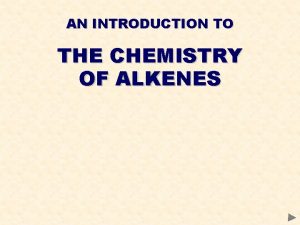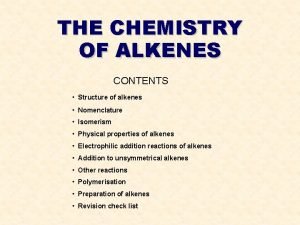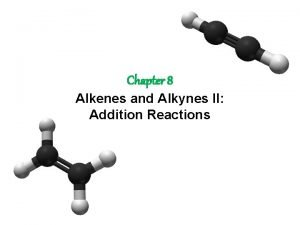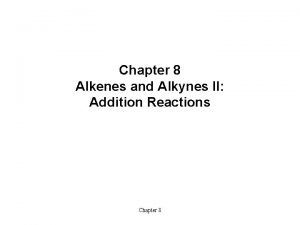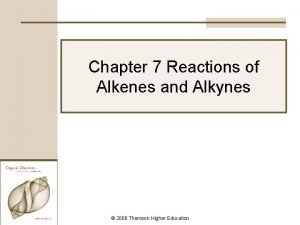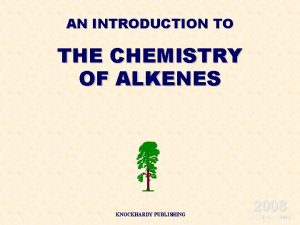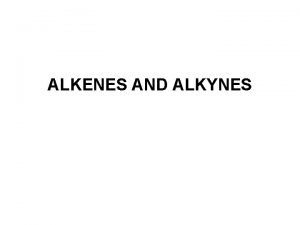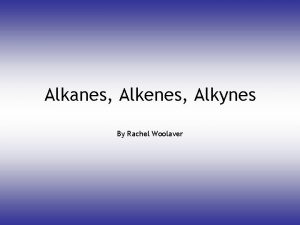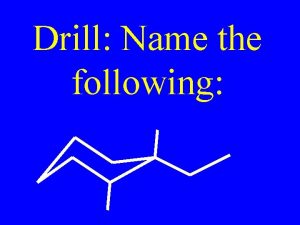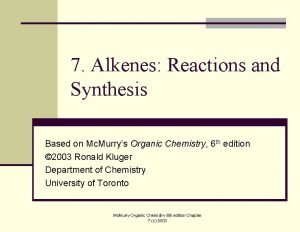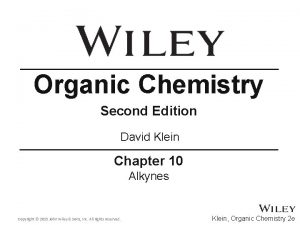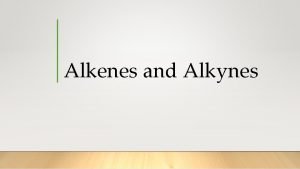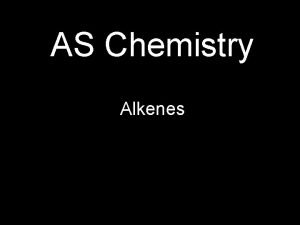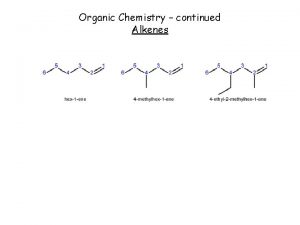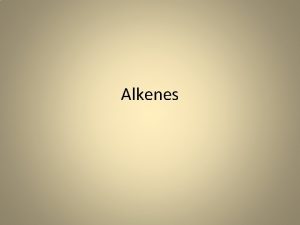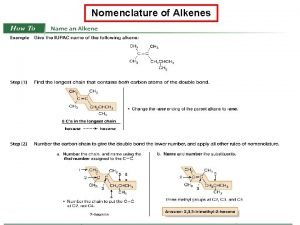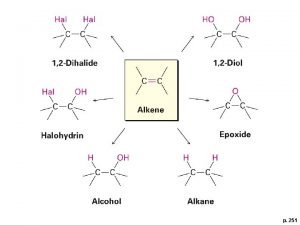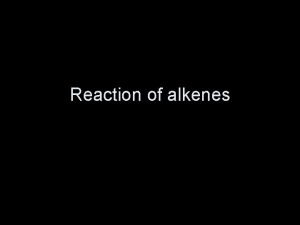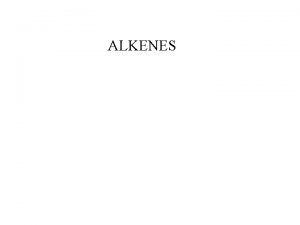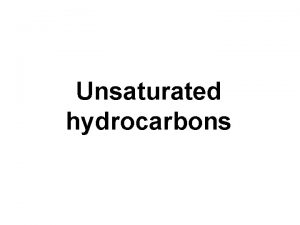AN INTRODUCTION TO THE CHEMISTRY OF ALKENES THE



















- Slides: 19

AN INTRODUCTION TO THE CHEMISTRY OF ALKENES

THE CHEMISTRY OF ALKENES Before you start it would be helpful to… • Recall the definition of a covalent bond • Understand the difference between homolytic and heterolytic fission • Be able to balance simple equations • Be able to write out structures for hydrocarbons • Recall the chemical and physical properties of alkanes

THE STRUCTURE OF ALKENES General members of a homologous series hydrocarbons - contain only C and H general formula is Cn. H 2 n - for non-cyclic alkenes unsaturated - atoms can be added to their formula contain a C=C double bond somewhere in their structure Structure spacial arrangement around the C=C is planar the bond angles are 120°

HYBRIDISATION OF ORBITALS - REVISION The electronic configuration of a carbon atom is 1 s 22 p 2 2 2 p 2 s 1 1 s

HYBRIDISATION OF ORBITALS - REVISION The electronic configuration of a carbon atom is 1 s 22 p 2 2 2 s 1 If you provide a bit of energy you can promote (lift) one of the s electrons into a p orbital. The configuration is now 1 s 22 s 12 p 3 2 p 2 1 s 2 p 2 s 1 1 s The process is favourable because the of arrangement of electrons; four unpaired and with less repulsion is more stable

HYBRIDISATION OF ORBITALS - ALKANES The four orbitals (an s and three p’s) combine or HYBRIDISE to give four new orbitals. All four orbitals are equivalent. 2 s 22 p 2 2 s 12 p 3 4 x sp 3

HYBRIDISATION OF ORBITALS - ALKENES Alternatively, only three orbitals (an s and two p’s) combine or HYBRIDISE to give three new orbitals. All three orbitals are equivalent. The remaining 2 p orbital is unchanged. 2 s 22 p 2 2 s 12 p 3 3 x sp 2 2 p

THE STRUCTURE OF ALKENES In ALKANES, the four sp 3 orbitals repel each other into a tetrahedral arrangement. HOWEVER. . . In ALKENES, the three sp 2 orbitals repel each other into a planar arrangement and the 2 p orbital lies at right angles to them

THE STRUCTURE OF ALKENES Covalent bonds are formed by overlap of orbitals. The resulting bond is called a SIGMA (δ) bond. An sp 2 orbital from each carbon overlaps to form a single C-C bond.

THE STRUCTURE OF ALKENES The two 2 p orbitals also overlap to form a second bond. This is known as a PI (π) bond. For maximum overlap and hence the strongest bond, the 2 p orbitals are in line. This gives rise to the planar arrangement around C=C bonds.

ORBITAL OVERLAP IN ETHENE - REVIEW two sp 2 orbitals overlap to form a sigma bond between the two carbon atoms two 2 p orbitals overlap to form a pi bond between the two carbon atoms s orbitals in hydrogen overlap with the sp 2 orbitals in carbon to form C-H bonds the resulting shape is planar with bond angles of 120º

NAMING ALKENES Alkenes are named according to standard IUPAC rules • select the longest chain of C atoms containing the double bond; • place the ending ENE on the basic name • number the chain starting from the end nearer the double bond • use a number to indicate the lower number carbon of the C=C • as in alkanes, prefix with substituents • side chain positions are based on the number allocated to the first C of the C=C • if geometrical isomerism exists, prefix with cis or trans e. g. CH 3 - CH = CH - CH 2 - CH(CH 3) - CH 3 is called 5 -methylhex-2 -ene

ISOMERISM IN ALKENES Two types of isomerism found in alkenes STRUCTURAL GEOMETRICAL

STRUCTURAL ISOMERISM IN ALKENES Different structures are possible due to. . . Different positions for the double bond pent-1 -ene pent-2 -ene Branching 3 -methybut-1 -ene

GEOMETRICAL ISOMERISM IN ALKENES Introduction • • an example of stereoisomerism found in some, but not all, alkenes occurs due to the RESTRICTED ROTATION OF C=C bonds get two forms. . CIS Groups/atoms are on the SAME SIDE of the double bond TRANS Groups/atoms are on OPPOSITE SIDES across the double bond Isomers - have different physical properties - e. g. boiling points, density - have similar chemical properties - in most cases

GEOMETRICAL ISOMERISM RESTRICTED ROTATION OF C=C BONDS Single covalent bonds can easily rotate. What appears to be a different structure is not. It looks like it but, due to the way structures are written out, they are the same. ALL THESE STRUCTURES ARE THE SAME BECAUSE C-C BONDS HAVE ‘FREE’ ROTATION Animation doesn’t work in old versions of Powerpoint

GEOMETRICAL ISOMERISM RESTRICTED ROTATION OF C=C BONDS C=C bonds have restricted rotation so the groups on either end of the bond are ‘frozen’ in one position; it isn’t easy to flip between the two. Animation doesn’t work in old versions of Powerpoint This produces two possibilities. The two structures cannot interchange easily so the atoms in the two molecules occupy different positions in space.

GEOMETRICAL ISOMERISM How to tell if it exists Two different atoms/group s attached Two similar atoms/group s attached Two different atoms/group s attached GEOMETRICAL ISOMERISM Once you get two similar atoms/groups attached to one end of a C=C, you cannot have geometrical isomerism GEOMETRICAL ISOMERISM

GEOMETRICAL ISOMERISM Isomerism in butene There are 3 structural isomers of C 4 H 8 that are alkenes*. Of these ONLY ONE exhibits geometrical isomerism. BUT-1 -ENE cis BUT-2 -ENE trans BUT-2 -ENE 2 -METHYLPROPENE * YOU CAN GET ALKANES WITH FORMULA C 4 H 8 IF THE CARBON ATOMS ARE IN A RING
 Alkenes introduction
Alkenes introduction Properties of alkenes
Properties of alkenes Propene undergoes addition reaction
Propene undergoes addition reaction Alkane chemical formula
Alkane chemical formula Chemsheets halogenoalkanes
Chemsheets halogenoalkanes Addition reaction catalyst
Addition reaction catalyst Syn addition
Syn addition Halogenation of alkenes
Halogenation of alkenes Physical properties of alkenes
Physical properties of alkenes General formula of alkene is
General formula of alkene is Alkanes alkenes alkynes
Alkanes alkenes alkynes Sp2 hybridization in alkenes
Sp2 hybridization in alkenes Name the following alkene:
Name the following alkene: Naming alkenes
Naming alkenes Diol formation from alkene
Diol formation from alkene Bromine water test
Bromine water test But-1-ene
But-1-ene What is ozonolysis give an example
What is ozonolysis give an example Ib chemistry organic chemistry
Ib chemistry organic chemistry Inorganic chemistry vs organic chemistry
Inorganic chemistry vs organic chemistry
